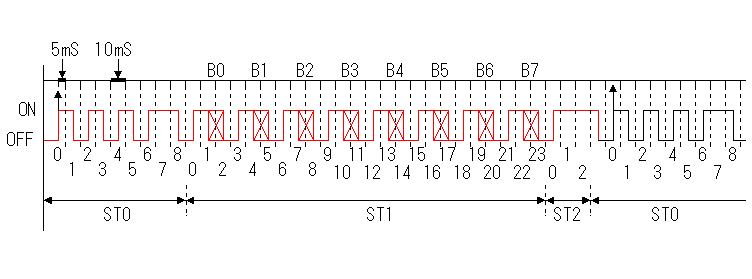Time Chart for Receiver

|
First, the receiver confirms that the electric wave exists. A 5-millisecond timer is set when an electric wave is received and the input signal becomes ON. The signal which is sent from the transmitter is a 10-millisecond interval. To detect ON/OFF in the position of the stable state, it is shifting for 5 milliseconds from the standing-up of the signal. The electric wave which is sent from the transmitter is composed of three blocks. In the program, it is managing three blocks by receiving status (RX_STATUS). ST0, ST1, ST2 show receiving status with the figure above. A bit in each block is managed by sub status (RX_SUBSTATUS). The figure which is written under the signal in the figure above shows sub status. When detecting the signal which doesn't match above-mentioned composition, the detection operation returns first and begins with the condition of the existence confirmation of the electric wave. First, the detection operation of the preamble signal is done. It detects ON-OFF three times, and it detects the ending mark (being OFF behind twice continuously ON) of the preamble and it is judged a normally preamble signal. It makes status "1" when receiving a normally preamble signal and the detection of the control code is done. Each bit of the control code is between the ON signal and the OFF signal. It is stored in CONT_DATA every time it detects each bit. It makes status "2" when receiving all of the 8 bits normally and it confirms an ending code. The ending code is a three times continuously ON signal. When receiving an ending code normally, the checking of a received control code is done. It is checked with the beforehand registered control code. As a result, the RB port which corresponds to the control code is controlled. When finishing receiving above signal normally, it makes the condition of the existence confirmation of the electric wave like the time of the receiving start-up. Receiving timing is set once again by this. The clock of the transmitter and the clock of the receiver aren't the same. So, when receiving long in the same timing, the timing shifts and sometimes becomes that it isn't possible to receive. If detecting the standing-up of the signal every time it receives each frame, the receiving timing doesn't shift. Only the case to become ON condition from the OFF condition is detected because it is using the last Look for the standing-up detection of the signal. |